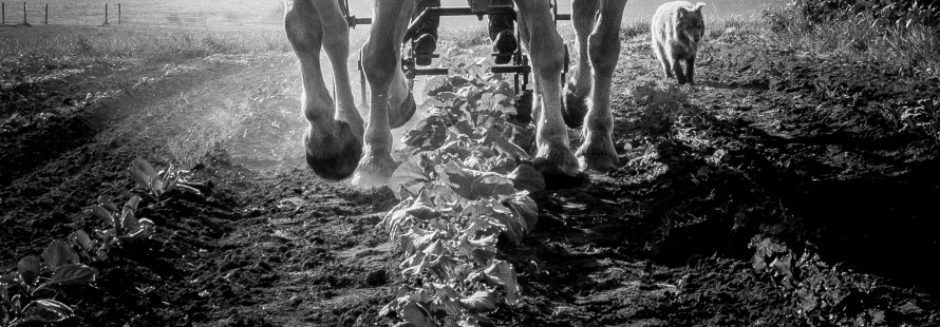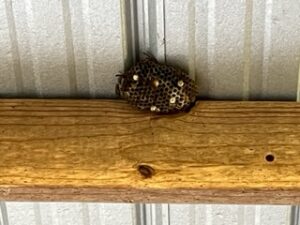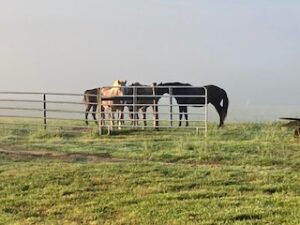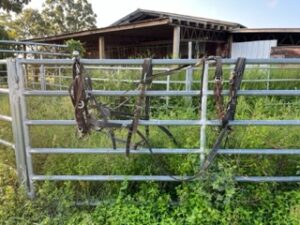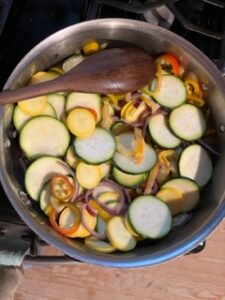“The serpent, the king, the tiger, the stinging wasp, the small child, the dog owned by other people, and the fool: these seven ought not to be awakened from sleep” -Chanakya
With the cooler temperatures, I decided it was time to put my big girls back to work. That, and I have broken every other piece of equipment we use in the garden this summer including the tiller that goes on the tractor. We have had that for over 20 years.
It takes time to talk the girls into work. Every morning I wake up and look out the window at them standing like this. Fighting flies. Waiting for breakfast.
I have to feed them in the corral to catch them, then brush them and love on them for a few days. Also, I had to pull my cultivator out of the weeds and get it ready for work. So, Saturday, I felt like we were ready.
I fed the big girls. I moved all the drip tape and other obstacles from the garden. Then, I went to attach my row weeding implement to the cultivator. Drug it out of the weeds and hmmm….where are all those black insects coming from? Rats, no bees!….a nest in the pipe of the implement I am dragging. To the house for the can of wasp spray.
I killed that nest, and then…off to harness the horses. We don’t have a horse barn (perhaps that is apparent by now), so my harness lives on a saw horse in a shed beside our hay barn.
Harness is heavy. The hames that go across the neck are metal, and the chains that pull the cultivator are heavy duty chains. In order to carry a harness, I put the britching and chains on my shoulder, then add the belly strap, then pick up the hames, one in each hand and drag it to the horses.
In this case, the weeds had grown up around the shed so I would be dragging through high weeds and a gate, then through the corral.
When I picked up the first harness I saw a yellow jacket on it. After inspecting the harness I did not see a nest attached, so through the weeds I go.
When I went to get the second harness, I had to pick up some of the chains, and straps to get them pulled off the sawhorse. I guess I bumped the red wagon they were sitting behind. I had already put the harness over my shoulder and was reaching for the hames, and here they came, the yellow and black assassins. I was determined not to be run out by those bees, but after the first sting I decided to drop the harness and run for cover. Tip and Diamond too. I looked but still could not see the nest. Stubborn to continue with my endeavor, I went around to the other side. After tripping and wading through all the stacked lumber and other stuff farmers tend to accumulate, I reached the wagon. It looked like the nest was under a tarp stashed towards the back of the wagon. I decided it was a two person job to kill those bees. When Curtis got home I said….I think one of us needs to lift the tarp and the other needs to spray it. He looked at me and said “I think I would like to be the one holding the spray can”.
Needless to say, maybe that is a job for next weekend. Perhaps we drag the wagon out so we have a clear path to runaway.
So the big girls went back out in the field to wait for fall, and frost and….no more bees! And I am stuck with hand tools that I have not broken….yet!
Farm News: some interesting facts about yellow jackets
*Yellow jackets live in some pretty strange places. If you go into an outbuilding or shed, you might find yourself face to face with a lot of angry yellow jackets. This is because they get into these places and build their nests in old furniture, stacked materials, and other unexpected things.
*Yellow jackets sting multiple times. Unlike many bees, these wasps don’t have a barb on their stinger. That means that, not only will they live long after they’ve stung you, they can sting you several times. So, it is no fun running into even a small nest of yellow jackets.
(got that right)
This time of year there are nests everywhere….and bees get meaner in the fall. At least the hornets kill flies….so I give them a pass. Honey bees and carpenter bees are pollinators, so I give them a gold star. All others in my book…”no fun”.
What’s in the bucket? Pepper Pallooza….pickle them, ferment and make hot sauce, stuff and freeze them. They are the highlight this week. Also, North Georgia Candy Roaster. These squash were cultivated by the Native Americans right here in North Georgia. And I quote another farmer in saying they are “Sweeter than a butternut…Better than a sweet potato.” Cut them in half and roast like any other winter squash.
Also…Okra, Arugula (makes excellent pesto), bunches of mixed kale, last of the summer squash and zucchini and/or eggplant, more Daikon (Yay!)… quick pickle them if they are adding up in your produce drawer:) I had hoped for green beans by now….but the deer and rabbits have been nipping the tender tops off and stunted them.
And the recipe and wine pairing from Scenic City Wines for the week….ratatouille.
Francesca Castaldi “Rosable” Rosato Colline Novaresi
I have a whole row of eggplant. I thought I would have thousands by now. But only a few trickling in. Bugs love eggplant leaves.
This is a no recipe recipe. Use what you have….lots of peppers, summer squash, an eggplant if you have it.
Ingredients:
2-3 sweet peppers, yellow, red or purple
eggplant and/or summer squash zucchini sliced thinly – enough to fill your skillet
half of an onion, thinly sliced
one clove of garlic, minced
2 T butter or olive oil or mix
one large tomato or 2 small
salt and pepper, parsley to taste, dried or fresh
grated mozzarella or parmesan
- Stir fry veggies in oil or butter. You might want to do the eggplant first separately if you don’t want it to be too mushy, then add when other veggies are done. But I am a fan of throwing it all in there together. Salt, parsley and pepper to taste
- slice tomatoes and lay over the top of your veggies in the skillet. A light sprinkle of salt on the tomatoes. Cover and continue to cook over low heat until the tomatoes render there juices.
- Heat oven to about 350 degrees. Remove lid and sprinkle mozzarella and/or parmesan over the top. Cook until bubbly and cheese is melted. Serve with short pasta such as penne or shells, or rice or crusty bread.
Happy eating, happy yellow jackets, and thanks for buying local food from Circle S Farm!
